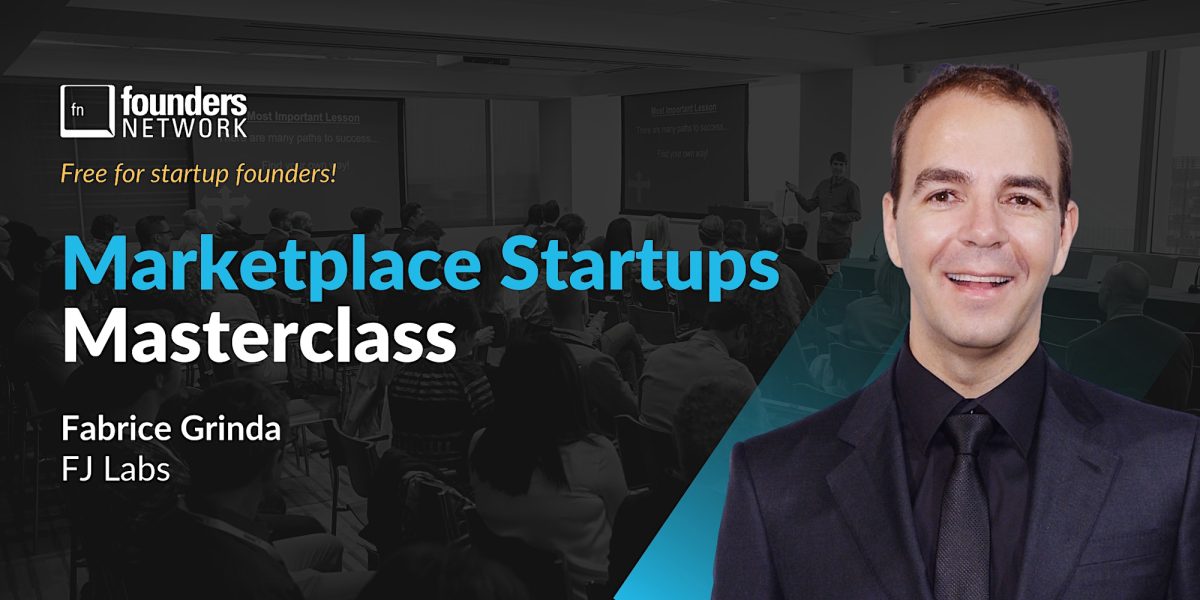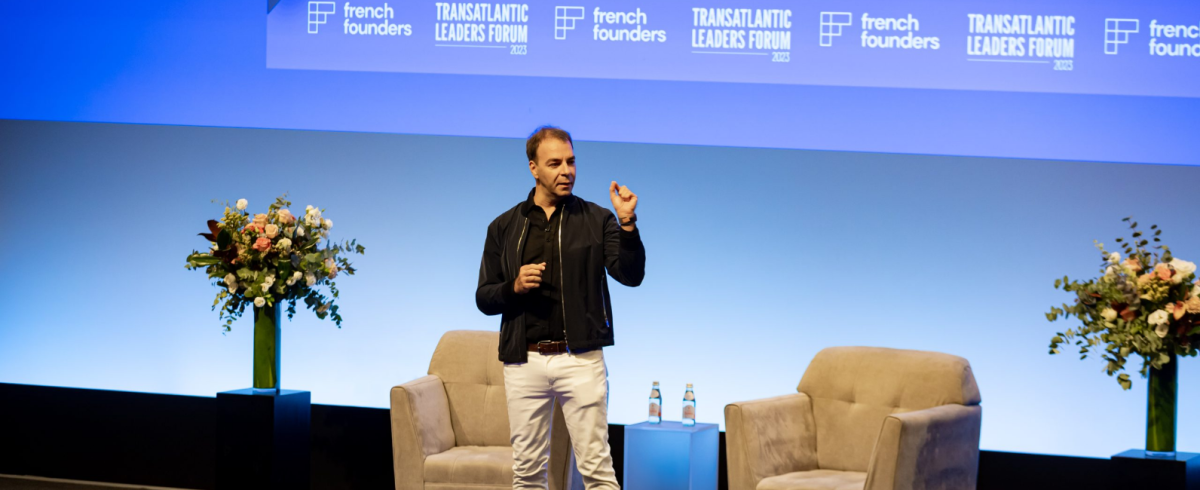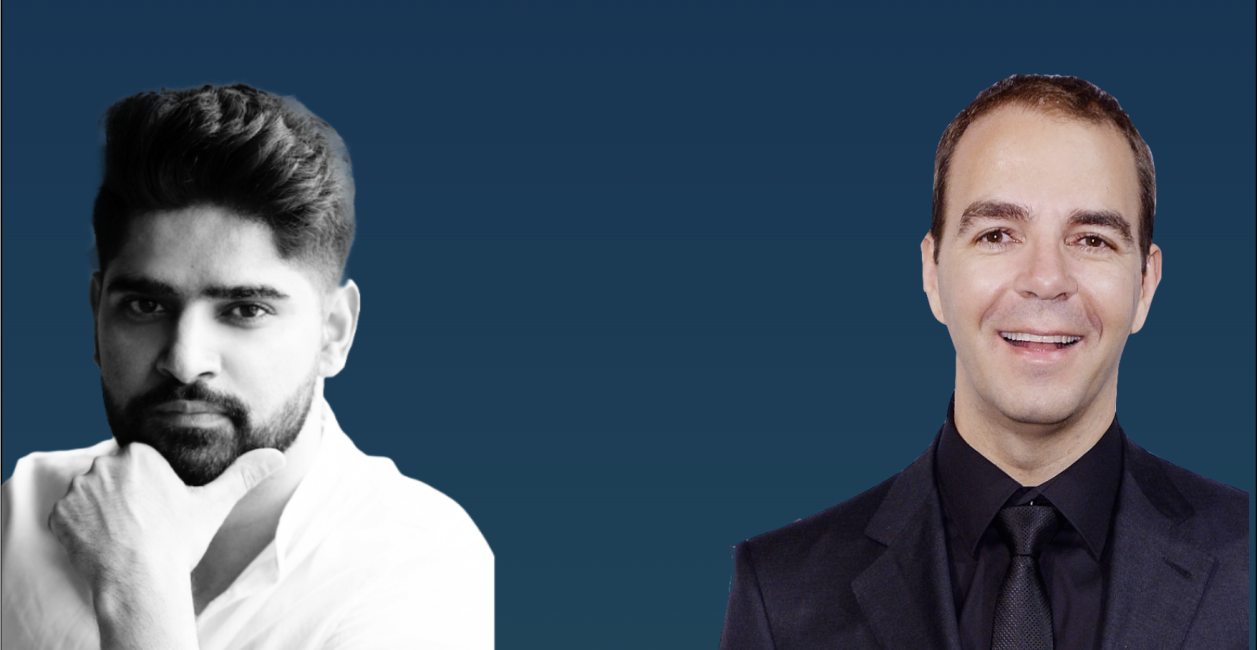I had the pleasure to be invited by Frenchfounders to speak at this year’s Transatlantic Leadership Forum hosted by Goldman Sachs. The event brought together over 500 leaders to explore themes of sustainable futures, technological advancements, and economic transatlantic collaboration.
I shared my perspective on the state of entrepreneurship. I covered where we stand in the macro cycle, its impact on entrepreneurship, my thoughts on AI as an investment opportunity, and FJ Labs’ current thesis.
Given how many times I was asked the question, it’s worth noting that I spoke without a teleprompter or notes. Practice makes perfect!
Here is a transcript of the speech for your reading pleasure.
It was the best of times, it was the worst of times, it was the age of wisdom, it was the age of foolishness, it was the epoch of belief, it was the epoch of incredulity, it was the season of light, it was the season of darkness, it was the spring of hope, it was the winter of despair. Charles Dickens words could actually not be more apt to describe the situation we find ourselves in today as founders and as VCs.
When it comes to tech, we seem to be stuck between the dichotomy and the crazy contrast between the irrational exuberance in AI and the fundamental inability to raise capital in every other category of tech, both as GPs trying to raise money from LPs and as founders trying to raise money. The economy seems to be teetering between different alternatives, unclear of where it’s going to settle between inflationary access, total collapse, and perhaps, hopefully, a soft landing.
And so, in these times of uncertainty, I want to take a few minutes to reflect on where we are and where we’re headed, especially when it comes to entrepreneurship. I want to first touch for a few minutes on the macro. Now, in the long run, the macro doesn’t matter because the trend of history is for unabated economic growth driven by productivity to exceed it.
In over 100 years, it’s irrelevant. But in the short term, there are periods of time where the macro trumps the micro. In 2021, because of overly loose fiscal and monetary policy, basically all asset classes correlated to one on the way up. People did not differentiate good assets from the bad, and everything became overvalued.
And that was true of real estate, stocks, of bonds, of tech, publics, privates, NFTs, SPACs, you name it. After the fastest raise in interest rates in history, the value of growth assets, especially, let’s say, less valuable publicly traded tech companies, fell by 80 percent or more for the most part. And there’s been a funnel of repricing, and now all assets correlated to one on the way down, and often the baby was thrown away with bathwater.
Today, most people believe that we’re in the post macro phase. Perhaps we are headed for a soft landing. But before I touch upon where we are in tech, I want to take a moment to consider that perhaps we’re not, the game is not over yet. In the last 70 years, there’s only been one time that we’ve had a soft landing, which was in 93 and 94.
And when I look at the underlying economic data, it gives me pause or concern. There’s about a trillion dollars of commercial real estate refinancing that needs to happen 2024. And with low occupation and a high interest rates, many of these projects are not financially viable. The building that my venture fund, works out of went bankrupt who was taken over by the bank, and I suspect that it’s an auger of things to come.
Banks are likely to be recipient of these low yielding assets at a moment where their deposit base is shrinking faster than ever before. Depositors are correctly concluding that they’re better off moving into high yielding, safer T bills than leaving money in their bank account. As a result, bank balance sheets are collapsing, which is going to shrink commercial lending.
There’s about 500 billion plus of S&P 500 refinancing the need to be happening in the next year every year for the next few years and much higher rates, which will shrink corporate profits. The U.S. Consumer is actually in dire straits. The high savings rate of the covid era is actually being depleted.
We have now higher debt than ever before in every major category. Higher mortgage, higher U.S. auto loans, student debt and credit card debt. Rates are now at the highest in the last 15 years for all these categories. Delinquencies are currently higher in credit card debt than they were in the Great Recession.
And 70 percent of millennials and Gen Z live paycheck to paycheck. The general sentiments in manufacturing services are also very negative. The PMI is at 46.7, 79% of the time has been below 47 in the US, it’s led to recession.
We have managers of the companies not realizing that rates are going to be higher for longer, and therefore delaying investment because many projects are no longer viable. And the geopolitical environment is also very bearish in the sense that normally do we have a seeming limitless quagmire continuing in Ukraine and Russia.
But at the same time, we have a beginning of a hot conflict in the Middle East, and likely, or at the very least possibly, a conflict between Azerbaijan and Armenia, and Serbia and Kosovo. In addition to that, the yield curve is currently negative. It’s been the most inverted it’s been since 1982. And the only time in the last 70 years that a yield curve inversion has not led to a recession was in 1966.
So, all that to say that I’m rather more bearish than the consensus. Now, these things are probabilistic. It doesn’t mean it will happen. But as I think through as a founder and as a venture, venture investor, what this means, in my toggle of greed to fear, it’s toggled to fear. As a GP in a venture fund, I’m writing smaller checks. I have a higher standard. I’m extending the runway not to be going to market in the next few years.
As a founder, you should be focusing on your unit economics, extending runway, decreasing your burn and making sure that your default alive. In 2023, though, we’ve invested in over 150 companies, and I can tell you that it’s been really hard for companies to raise. And so, the line or sentence of the year might be that the flat extension to the last round, meaning same valuation as two years ago is the new up round. And the up rounds are far and few between outside of AI, which I will touch upon shortly.
But despite all this gloom and gloom, you know, the macro doesn’t last forever. On average, recessions have lasted 12 months and the longest one in the last seven years has been 18 months. And actually, paradoxically, I would argue that today is the very best time in recent history to both build a startup and/or invest in a startup. Yes, valuations have reset. So right now, we’re seeing pre seed valuations about 5 pre, raising 1.
Seed valuations, let’s say you’re doing 30k a month in MRR, 150k in GMV if you’re a marketplace. You’re raising 3 at 10 pre, 13 post. And, Series A valuations of like seven at 23 pre when you’re doing 150K MRR, and 500K plus in GMV. These are significantly down from where they were in 21, 22, but we’re back to the medians of 2016, 2019.
Now what’s interesting is, despite the fact that as a founder, raising at a lower valuation, and most likely it’ll take longer to scale your business, and most likely your exit multiple will be lower. This is actually a better time to be building a company than two years ago. You can take your time, focus on your economics, focus on your burn, and make sure you build a viable business.
And most importantly, you’re not facing as much competition as you were. In 2021, if you were building a company that was interesting, you probably had 20 very well-funded competitors doing the same thing, forcing you to do things that were uneconomic. Today, if you win the category, if you’re in a category, you’re facing few competitions, you’re likely to win the entire category, leading to extraordinary exits.
In the 2020s, the 2010s, the very best companies were invested in, in 08, 09, 010, 011. Airbnb, Uber, Instagram, WhatsApp, all weren’t built in that time period. I suspect that the very best companies of the 2020s will have been built or come of age in the 22, 23, or 24. So right now is an amazing time both to be a founder and to be an investor to the extent you have the dry powder and you’re investing in or building an acid light businesses where you get to the metrics that I highlighted before for your next round and where you’re not going to market for the next two years. So, make sure you have two years of cash.
Now what to focus on? Clearly the buzzword of the year has been AI. And everyone’s been extraordinarily excited about AI, and in many cases with good reason. What you can do with GPT, or with Tome and Beautiful for presentations, or, with MidJourney for graphics and others is extraordinary.
But as an allocator of capital, I need to think through, you know, what are the returns I’m going to be getting in the investments I’m making? And right now, it really feels that you’re at the very top, or maybe even past the top of the hype cycle when it comes to AI. Now, I do not underestimate the impact AI will allow in the world.
Like every other tech that came before, I suspect we’re overestimating its impact in the short term, and massively underestimating the impact in 10, 15, 20 years. In the late 90s, when the first bubble came of age, people thought the Internet would change everything immediately. They were right that it did change everything 20 years later.
But the first bubble, of course, laid the foundations for the success to come. So right now, when I’m seeing all these billions of dollars of investments in non-differentiated LLM models at very high valuations with no moats and no business models, I suspect that many of these will fail and will not be great for the investors.
That said, will be amazing for consumers. It’s not a safe. Don’t do you know AI every company we invested in essentially is an AI company. Everyone’s using AI to lower cost of development. to do customer service and to improve user interfaces. But I would focus on vertical AI applications, on proprietary data sets, and categories where people are willing to pay.
You know, we’ve invested in a company like Numerai, which is an AI stock market, or a stock event market evaluation engine where people upload their models, and then it picks the best ones to create a fund out of it. Or company like Anduril, which uses AI for defense applications, or existing companies are using AI to improve user interfaces.
We’re investors in a French company called PhotoRoom, which basically you take a photo, it identifies the item based on what you’re selling, it’ll change the background, increase the sell through rate, absolutely crushing it. One of our portfolio companies, a company called Rebag, which is a handbag marketplace selling 2,000-euro type handbags. If you take a photo of the handbag, it’ll tell you if it’s real or fake, the model will auto populate category, title, description, and price, and your handbag is sold in minutes. Compare that to the traditional process for selling items on normal marketplaces like eBay.
Now, I’m telling you that on average, don’t focus actually on AI, what is it that I’m most excited about today? And the reality is we’re at the very beginning of the tech revolution.
You know, if you look at the consumer world, you have these extraordinary user experiences. On Amazon, things are delivered the same day if you’re in a city like New York. I mean, that’s mind bogglingly epic. Uber, Airbnb, it’s amazing. In the business world, though, we’re in the dark ages. Relationships are managed by email or text. If you want to order petrochemicals, there’s no catalog. Not only is there no catalog, there’s no price on the catalog. There’s no connectivity to the factory to understand manufacturing capacity. There’s no way to order online. There’s no payments, there’s no tracking, there’s no insurance, and there’s no financing. All of these could be different companies. So, what we’ve been focusing on is digitizing the B2B world, where we’re at sub 1 percent penetration in trillion-dollar categories.
So, five subcategories. One is creating supply chains and bringing supply chains online for all the inputs. So, a company like Knowde for petrochemicals. Metaloop in Austria for steel. Schutfflix, a company in Germany for gravel, which is a three-sided marketplace between the queries, the truck drivers, and the construction sites.
And you can do this across every single input, be they finished or raw. Number two, we’ve been helping small businesses compete with the large chains. You know, imagine you started a small business. You didn’t get into it because you like managing people, and doing accounting, and getting a POS, et cetera.
You know, if you create a pizzeria, it’s because you like cooking pizza. If you own a small coffee shop, it’s because you like being a barista and talking to your customers. So, we’re investors in companies like Slice, which helps the mom-and-pop pizzerias compete with Domino’s by creating the websites, answering comments in Google and Yelp and TripAdvisor, doing online delivery for them, um, providing the POS.
Or Odeko, which helps coffee shops compete with, with Starbucks by replenishing their inventory, giving them general purchasing power, volume. And they have super high NPS because they have the keys. They go in at night and replenish the inventory and don’t bother people. And we do this in every category.
A company like Jobox for locksmith, a company like Fresha for barbershops, and the list goes on.
Number three, big trend that I’m focusing on, is French shoring. Everyone needs to be moving for geopolitical reasons and economic reasons, their supply chains out of China, especially into India. And so, we’ve been helping SMB mom and pop manufacturers in India sell into the West.
Again, the SMB owner of a factory in India, he wants to manufacture. He doesn’t want to be answering RFQs and doing prototyping and dealing with invoicing and shipping and insurance. So, we’re doing it for them with a variety of marketplaces for linen, for apparel, for ceramics, for every major vertical you can imagine.
And we’re investing in labor marketplace is to support these we’re investors in a company like JobandTalent, which is providing blue collar workers in Europe, or TrustedHealth, which is providing nurses in hospitals in the US.
And fifth, last but not least, and things we’re interested in, and then I’ll touch upon other things. We’re investors in, in the infrastructure layer that supports all of these. So, a company like Flexport, which is a digital freight forwarder helping connect the world, shipping, because if you’re shipping or selling something from a factory in India, you have like a trucker to a warehouse, to a container ship, to another trucker, to another distribution point, all the way to the end customer.
And these historically have not been integrated. Or ShipBob, which is a warehouse picker, packer, last mile delivery company for online and offline retailers. Beyond that, I’m seeing extraordinary opportunities. It’s giving me hope that we’re going to rise up to the challenge of the 21st century.
And clearly, we’re facing inequality of opportunity, the mental and physical well-being crisis, and climate change. And in all of these, I’m seeing startups address the problems at hand. In the climate transition, today, solar plus batteries has become price competitive with all other forms, to the point that penetration is increasing faster than ever before. You don’t notice it yet because it’s from a low base, but it’s growing exponentially. And because efficiency and prices continue to decrease, the energy transition will happen within the next 20 to 30 years for sure. I’m so profoundly optimistic. And when you see what’s being in the labs developed in the labs right now at the battery level, it’s extraordinary.
Likewise, we’re investors in a company called Figure AI, which does humanoid robots, replacing humans in last mile warehouses for picking and packing. Again, it’s massively deflationary, in fact, all the things I just described are massively deflationary. By definition, they are inclusionary. They will increase people’s purchasing power.
But it’s massively deflationary, improves quality of life for humans by replacing humans who are doing tasks they should not be doing that are highly repetitive and manual. We’re investors in a brain computer interface company called Paradromics, which gives hope to tetraplegics or people with Lockton Syndrome by allowing them to use their brain to communicate with the rest of the world.
So, all that to say that all of us here today, as founders, as investors, we’re extraordinarily privileged to be in a position to bring about a better world of tomorrow. A world that is environmentally sustainable, of equality of opportunity, and of plenty.
Thank you.


